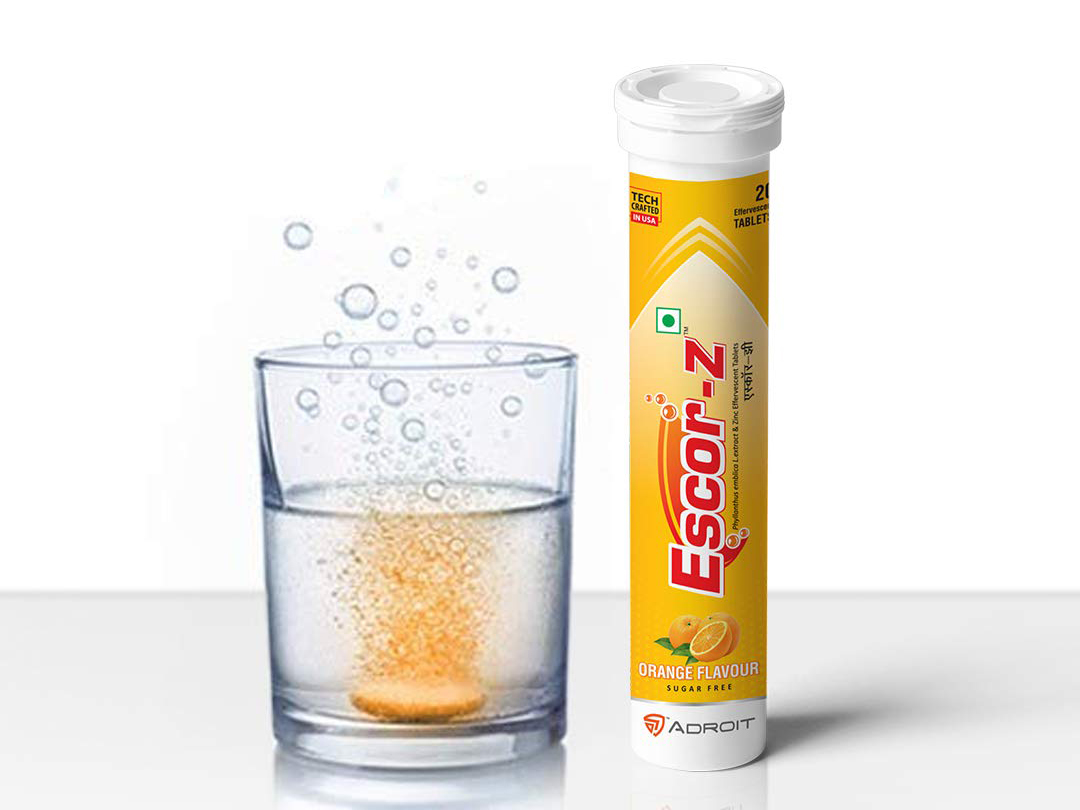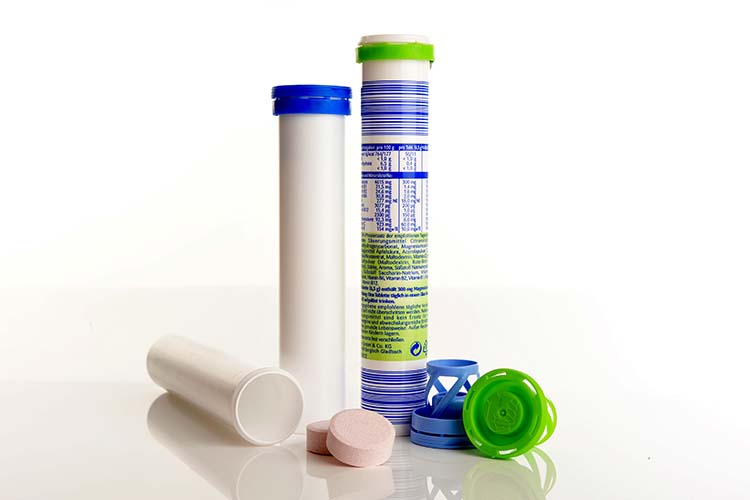
Different from ordinary tablets, effervescent tablets use organic acid and basic bicarbonate to react as effervescent disintegrant. When placed in water, an effervescent reaction occurs immediately, generating and releasing a large amount of carbon dioxide gas and producing foam. This kind of tablet is generally used to carry medicine, or cleaning products such as biological enzyme lotion. Effervescent tablets are a good choice as a dietary supplement
What Are Effervescent Tablet?
The prescription of an effervescent tablet consists of the main drug, diluent, binder, disintegrant, lubricant, and other auxiliary materials. The diluent, binder, lubricant, and other auxiliary materials used are the same as ordinary tablets. The appropriate variety should be selected according to the preparation process. Different from ordinary tablets, the disintegrant used in effervescent tablets is effervescent. The effervescent disintegrant includes an acid source and an alkali source. Commonly used acid sources are citric acid, malic acid, boric acid, tartaric acid, and Malic acid, inorganic mineral acid (hydrochloric acid), etc.; commonly used alkali sources are sodium bicarbonate, sodium carbonate, and a mixture of the two. The acid-base ratio has a significant effect on the preparation and stability of the effervescent tablet. It is generally believed that the amount of acid exceeds the theoretical amount, which is beneficial to the stability of the effervescent tablet and the improvement of the taste.

Why Effervescent Tablets Are Used?
Compared with ordinary tablets, effervescent tablets have the advantages of novel dosage form, good taste, high bioavailability, convenience to carry and transport, etc. Its disadvantages are the complex production process, high cost, and strict packaging requirements. At present, effervescent tablets are widely used in the fields of medicine, food, health products, solid beverages, and pet medicines.
According to the composition of different raw materials. Effervescent tablets can be divided into four categories: tea effervescent tablets, fruit and vegetable effervescent tablets, vitamin effervescent tablets, and trace element supplement effervescent tablets, of which vitamin effervescent tablets are the most common.
Vitamin C effervescent tablet is a medicine with adjuvant therapy. Therefore, vitamin C effervescent tablet has its medicinal value.
1. Convenient to take and quick to take effect.
2. High bioavailability and remarkable clinical effect.
3. The flavored effervescent tablet tastes better and people are more willing to accept it.
4. Improve the body’s vitamin content and restore body functions.
5. Prevent various acute and chronic infectious diseases, scurvy, and other diseases.
6. Promote antibody production and inhibit excessive proliferation of cells.
How is Effervescent Tablet Administered?
- It is not advisable to soak in tea or beverages to prevent chemical reactions
- Children need to be taken under the care of their parents
- Vitamin C effervescent tablets should be drunk immediately, and vitamin C will not be oxidized after being placed for a long time
- When using effervescent tablets, the water temperature should not be too high, about 40℃, especially for vitamin C effervescent tablets, the too high water temperature will seriously affect the efficacy
- After taking vitamin C effervescent tablets, rinse your mouth with water to reduce the irritation of acidic substances to teeth and avoid tooth damage
- Effervescent tablets contain a lot of sodium. Taking a large amount for a long time will increase the risk of cardiovascular and cerebrovascular diseases. Therefore, people with high blood lipids and blood pressure, family history, or other risk factors for cardiovascular and cerebrovascular diseases should use less or cautiously effervescent tablets. Elderly people who commonly use effervescent tablets should pay attention to monitoring their blood pressure, and patients with hypertension should appropriately reduce their salt intake during the period of taking

The correct way to take effervescent tablets is to take half a cup of cold water or warm water (100-150ml), put a single dose of tablets into the cup, wait until the bubbles have completely disappeared and the medicine has completely melted, then shake it and take it.
Effervescent VS Tablet Vitamin C
Are effervescent and tablet vitamin C the same in effect?
Vitamin C tablets are medicines, used for the treatment of vitamin C deficiency, strengthen the body’s resistance, prevent allergies, and also have the effect of the ascorbic acid disease. Vitamin C effervescent tablets are health products, neither of which can be taken for a long time.
- Different properties: Vitamin C has a structure similar to glucose and is a polyhydroxy compound. Vitamin C effervescent tablets, the indication is to enhance the body’s resistance, are used to prevent and treat various acute and chronic infectious diseases or other diseases.
- Different properties: Vitamin C effervescent tablets are white or slightly yellowish tablets, with small yellow spots scattered on one side. Vitamin C is a white crystal or crystalline powder.
- Different components: Vitamin C forms antibodies and collagen, tissue repair (including some redox effects), metabolism of phenylalanine, tyrosine, and folic acid, utilization of iron and carbohydrates, and synthesis of fats and proteins. Each vitamin C effervescent tablet contains 1.0 g of vitamin C. The excipients are lactose, citric acid, and sodium bicarbonate.

Effervescent Tablet Production
At present, there are two types of effervescent tablet sugar manufacturing processes, namely, compression after granulation and direct compression. The production process of tableting after granulation can be divided into wet granulation and dry granulation and tableting. Direct tableting includes powder tableting and crystal tableting. However, at present, wet granulation and tableting are often used.
1. Tablet Pressing after Granulation Process
1) The Purpose of Granulation
① The fine powder of the material has poor fluidity and is not easy to evenly flow into the die hole, which affects the accuracy of the weight of the sugar tablet. After being made into pellets, it can overcome the difficulty of tableting due to poor fluidity.
② There is a certain amount of air in the space between the particles and the powder. When the tablet is pressed, part of the air in the powder cannot escape in time and is compressed in the sugar tablet; when the pressure is released, the air inside the sugar tablet expands and causes looseness. Cracking; At the same time, powder tableting requires high requirements on the tablet machine, which is easy to damage the machine. After the granules are made into tablets, the pressure requirement is smaller than that of powders. Due to the uneven surface of the granules, they have an “inter-embedding” effect, which can overcome quality problems such as sugar chip cracking.
③ Different raw material powders in the ingredients have large differences in specific gravity. When the tableting process is summarized, due to the vibration of the tablet press, the light and heavy components are layered, and the components of the compressed sugar tablets are inconsistent and the content is uneven.
④ Solve the quality problems such as the easy stickiness of fine powder, and avoid the flying of fine powder when the powder is directly pressed.
Due to the above reasons, except for some crystalline raw and auxiliary materials that can be directly compressed into tablets, powdered raw and auxiliary materials are generally granulated and then compressed.
2) Wet Granulation Process
The preparation method of the effervescent tablet wet granulation is as follows: the acid and alkali and suitable raw and auxiliary materials are divided into groups to make soft materials and granules with a binder, and the groups are dried, sizing and mixed and then compressed. The specific operation methods include a one-step method, two-step method, three-step method, and fusion method. The so-called one-step method is to divide the granulation into several groups, and the three-step method is to appropriately divide the raw and auxiliary materials and the acid-base system into three groups, respectively make soft materials and wet particles, and dry them in groups. The process:
① Preparation and pretreatment of raw and auxiliary materials: Before granulation, the raw and auxiliary materials generally need to be crushed, sieved or dried. The fineness of the materials is generally suitable to pass through a 80-100 mesh sieve.
②Material mixing: Pour various materials into the mixer and mix evenly according to the requirements of the formula.
③Making soft materials: Put the mixed materials in a trough mixer, stir and mix, and add an appropriate amount of wetting agent or adhesive.
④Making wet granules: Sieve the soft material through a suitable screen to form wet granules. Oscillating granulating for mass production, the granules should be complete, and without too much fine powder When sieving, if it is long or coarse particles will be firm, and particles containing fine powder will be loose. The easy-to-split tablets should make the granules firmer, and the compressed sugar that is sticky and difficult to disintegrate should be made into looser granules.
⑤Drying: After the wet granules are made, they should be dried immediately, since they may be deformed or agglomerated under pressure after long rotation.
⑥Granulating: The wet granule is called dry granule after being dried. During the drying process, a part of the particles adhere to each other into agglomerates, so they must be sieved and granulated to become uniformly sized granules that are easy to be compressed into tablets. The dry granules are sieved by a granulator to prevent too much fine powder, and then add the lubricant that has been sieved, and mix well. If it is necessary to add dry starch as a disintegrant, it should also be added during the granulating process.
⑦Total Mixing: It is the last operation of dry granule processing. The purpose is to make the various components in the dry granule uniform. The V-shaped mixer is commonly used in production.
⑧Pressing: the process of pressing the granules into a tablet press. The press operation steps are as follows: adjust the tablet weight of the produced varieties to make them consistent; add materials, pressing, and pushing tablets, completed.
⑨Selection: reject unqualified effervescent tablet in the formed pressed slices.
⑩Packaging: use a blister packaging machine or pillow packaging machine which needs to be sealed, airtight, beautiful, and complete.
The disadvantages of the wet granulation process are easy to absorb moisture and crack
The effervescent tablet made by the commonly used wet granulation process is insufficient because it is easy to absorb moisture and cracks appear.
(3) Fluidized Spray Drying Granulation Method:
The operation steps of mixing the raw materials and auxiliary materials, adding the binder, stirring and granulating, and drying are completed in one piece of equipment, which is also called one-step granulation.
(4) Dry granulation
Generally, the rolling method is used. After the materials are evenly mixed, they are uniformly rolled by a rolling machine and pressed into thin slices with the required hardness and thickness. After mixing, it can be compressed into tablets. However, since the pressed sheet is easy to stratify and may produce splits when the sheet is formed, and the equipment used is huge, this method has not been widely used.
2. Direct Press Process
Refers to the method of directly compressing the raw materials after sieving and mixing.
In addition to direct powder compression, there is also a crystal direct compression process. Certain crystalline granular materials have good fluidity and compressibility, and many materials containing crystal water can be directly compressed by adding appropriate lubricants. However, it is easy to burst in the process of tablet pressing.
At present, the dry-method direct compression process still has certain defects, and the requirements for the tablet press are high. This large pressure will cause serious wear on the tablet press and die, which will greatly shorten the service life of the equipment. During the process, the powder will fly, which not only pollutes the production environment but also endangers the health of employees. It also causes waste of raw and auxiliary materials and increases production costs.
Effervescent Tablet Granulation
(1) Crusher: The crushing function of the crusher includes shearing, impacting, grinding, squeezing, splitting, and so on. There are mainly two types: impact high-speed crusher and round screen wind-driven high-speed crusher.
(2) Mixer: A trough mixer is often used when making soft materials; a mixer is often used when adding lubricant before pressing, such as a V-shaped mixer, that is, the particles and auxiliary materials are placed in the mixing machine and rotated for a suitable time.
(3) Granulating Machine: Oscillating granulating machines and rotary granulation machines are mostly used. Rotary granulation machines are better, which can prevent the metal from being brought into the granulates due to the rupture of the screen.
Effervescent Tablet Drying
(1) Drying oven: drying oven with simple structure. When drying with this type of dryer, the soluble components contained in the particles can “migrate” between the particles, causing differences in the content of soluble components between the particles, affecting the uniformity of the sugar slices, so frequently flip the particles in the disc during drying. This can not only reduce the difference in the content of soluble components between the particles but also speed up the drying. It usually takes 2h.

(2) Fluidized bed dryer: A method in which wet particles are “fluidized” with hot air, and heat exchange and drying are carried out in the fluidized state.
(3) Fluidized spray granulation: Also known as the one-step granulation method, this method can complete mixing, granulation, drying, etc. in one set of equipment.
The advantages and disadvantages of the drying room and fluidized bed drying equipment are as follows:
Advantages of drying oven: suitable for various varieties and small batch production.
Disadvantages: long drying time, high labor intensity, and low production efficiency.
Advantages of fluidized bed: low drying temperature, uniform drying, high heat energy utilization; convenient operation, large output, high labor productivity, suitable for continuous operation of the same species.
Disadvantages: The equipment is not easy to clean.
Effervescent Tablet Press
(1) Single-punch tablet machine: generally used for trial production of new products or small-volume production.
(2) Rotary tablet press: It is a widely used tablet press at present. The feeding method is reasonable, the difference in tablet weight is small, the upper and lower sides are pressurized, the pressure is distributed evenly, and the output is high.
(3) Double-layer and multi-layer tablet machine: it is a special equipment for double-layer and multi-layer tablet sugar. Equipped with matching hopper and quantitative feeder, the structure principle is similar to that of the rotary tablet press.
Determination of packaging form and packaging materials: The packaging of effervescent tablets can be pillow-type heat-sealing, fruit foil, goldfish folding, small cylindrical plastic bottles and other packaging forms. The common packaging form of effervescent tablets and confectionery tablets is the packaging form of medicinal tablets, that is, blister packaging with plastic and aluminum foil composite packaging.
Effervescent Tablet Packaging

The packaging of effervescent candy can be in pillow-type heat-sealing, folding, small cylindrical plastic bottles and other packaging forms. The common packaging form of effervescent tablets and confectionery tablets adopt the packaging form of tablets, that is, blister packaging with blister and aluminum foil composite packaging.
Common effervescent tablets on the market are packaged in effervescent tablet tubes. Due to the particularity of the medicine, the requirements for bottling in terms of moisture-proof and airtightness are very high. Effervescent tablet tubes are currently made of polyethylene, and the moisture resistance is mainly reflected in the bottle cap. The bottle cap is composed of silica gel, spiral ring and small medicine chamber. Silica gel plays the role of absorbing moisture inside, which can prevent the drug from deteriorating after absorbing moisture. The spiral spring here plays a role in protecting the tablet drug, which can prevent the tablet from shaking during transportation. It is used to contain silica gel desiccant to prevent children from eating it by mistake and play a protective role. The desiccant is separated from the medicine, so that the medicine is not affected. The combination of the bottle and the bottle cap can play a very good seal and can stabilize the environment in the bottle.
Automatic plastic tube filling machine utterly adopts a PLC for centralized control. It is verified in fiber and photoelectric detection and other kinds of detection to have steady performance and reliably automatic operation.
Effervescent tablets tube filler machine for bobbin bottles is applicable to the packing of bigger and thinner tablets which are orderly fed into bobbin bottles/tube in a single row in an overlapping way.
